The Hunts of Hunter
by Imogene (Ousley) Vanderburg, great-grand-daughter of Edward Shannon & Elizabeth HuntDuring my life I have heard and read many stories about the Hunts of Hunter. After twenty plus years of family research I have learned that many of these stories did not happen exactly as they were told. My purpose in writing the following is to try and correct, at least, some of these stories. Also, it seems that there has been some who have doubted the fact that Hunter was named for Edward Shannon Hunt. I hope to put this doubt to rest. The Hunt family and Hunter were so entwined in those early days it would be hard to tell about this family without telling a little about the town.
They came to the land that would eventually become Hunter, down the rivers on a flat boat to Hopefield, present day West Memphis, Arkansas, continuing their journey down the " Military Road" by wagon, horse-back and on foot.
One story I have heard all of my life, " Edward Shannon Hunt was in Arkansas during the time he served in the Civil War." Shannon Hunt did serve in the Civil War, he enlisted for three years, served about a year and a half, the war ended and he was discharged. He did not serve the entire four years as stated in his obituary and he was never in Arkansas during the time he served in the War. I have copies of his military records and a copy of his regiment's history.
I have also read this story, " During the years when Jackson took the Indians west, a young soldier named E. Shannon Hunt helped build the Old Military Road as they went westward. Mr. Hunt found a spot along that road, and decided someday it would belong to him. " I don't think so, assuming that this Jackson referred to was Andrew Jackson. Andrew Jackson's second administration was 1833-1837, he died June 08, 1845. Jackson was in office during the time of " The Trail of Tears" but Shannon Hunt would have only been three years old when Jackson died.
However, I do have reason to believe that Shannon did work on the Military Road in Arkansas but it would have been several years after the death of Jackson and just prior to his having entered the Civil War. It is for certain that Shannon was in Arkansas before he came in 1879 and that he was well acquainted with the Military Road. I also believe the following statement to be true, " Shannon found the area to his liking and made a vow to himself that he would one day return and build his house near and facing the Military Road." I do know the " Old Military Road" (as it was always referred to by this family) was very important to the Hunt family.
Edward Shannon Hunt was born December 03, 1842, not 1841 as shown on his head-stone. He was born near Lebanon, Warren County, Ohio, to Ralph Hunt and Nancy Agnes (Smith) Hunt. Shannon had one brother, Alexander Smith Hunt, who remained in Indiana and one sister, Martha Emaline Hunt, who died in Warren County, Ohio, before she was two years old.
Edward Shannon Hunt, at the age of twenty-one, enlisted on February 17, 1864, at the town of Morrow, Warren County, Ohio. On February 18, 1864, he was sworn in at Cincinnati, Ohio, as a private in Company A of the 79th Regiment, Ohio Infantry Volunteers. He enlisted for three years but the war ended and he was only in for about a year and a half. His enlistment papers states that he had blue eyes, brown hair, light complexion, was six feet tall and his occupation was farming. Also, that he was to be paid a three hundred dollar bounty, at which time he was paid sixty dollars and was due two hundred and forty dollars.
Shannon served under Gen. Sherman, he was in Atlanta during " The Atlanta Campaign" and was present at and took part in the final " Grand Review" of armies of Grant and Sherman at Washington on May 24, 1865.
General William Tecumseh Sherman was to have said, " War is hell." I'm sure Shannon shared his feelings. It has been said that Shannon was not proud of having had a part in the destruction and looting during this war.
The Civil War total casualty release was; The Union - 359,000 dead, 100,000 wounded; The Confederacy - 280,000 dead, 100,000 wounded. 50,000 were sent home amputees.
Unlike many of the Civil War Soldiers, Shannon did return home, but the war had cost him his health.
Shannon was honorably discharged on July 20, 1865, the war was over. He returned home to Warren County, Ohio, and most likely to the sweetheart he had left behind. Edward Shannon Hunt and Elizabeth Ann Williams were married on Wednesday, September 05, 1866, in Warren County, Ohio. They were married by Rev. W.M. Maxey.
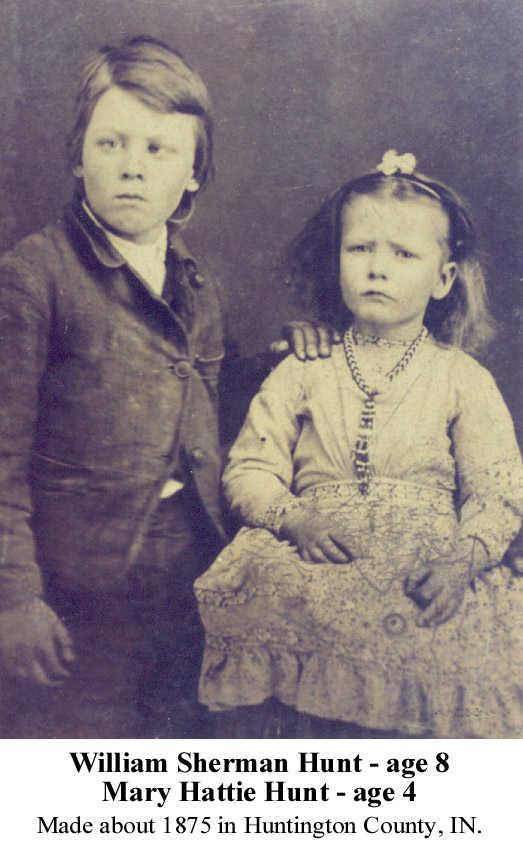
Soon after Shannon and Elizabeth were married, they along with Shannon's parents, Ralph and Nancy Agnes and his younger brother, Alexander, moved to Huntington County, Indiana. Shannon and Elizabeth remained in Huntington County for about twelve years. During this time three children was born to this union, William Sherman Hunt was born on Sunday, June 09, 1867; Mary Hattie Hunt was born on Sunday, August 13, 1871; and Sylvester Coot Hunt was born on Monday, November 06, 1876.
There were delays but Shannon did not give up his dream of coming to Arkansas. The war was one delay, another was likely because Union Soldiers were not always welcome in the south right away after this war. Shannon most likely was afraid to bring his family south so soon after the war.
In 1878, while still living in Huntington County, Indiana, Shannon and Elizabeth bought a 120 acres and 60 acres along the Military Road in Woodruff County, Arkansas. I have copies of these deeds, this land was bought in Indiana, in 1878, the year before Shannon and Elizabeth came to Arkansas.
We know that Shannon and Elizabeth came to Arkansas in 1879 but we do not know the exact date they left Indians or the exact date they arrived in Arkansas. I do have a copy from an old grocery store ledger from Zanesville, Indiana, which shows the last entry for Shannon Hunt as July 25, 1879. Shannon also leaves this forwarding address as; Shannon Hunt, Wheatley, St. Francis Co., Arkansas.
By this time Shannon's mother had died and his father, Ralph, was coming to Arkansas with them. Hazel (Hunt) Lewton told me, " Grandpa Alex told me that Ralph, Shannon and he had always gotten along really well, they never argued, but when Shannon was bringing Ralph to Arkansas they had a big fight. Grandpa Alex told Shannon that Ralph was an old man, too old to go to Arkansas." Ralph would have been sixty-nine years old.
Hazel said, " Grandpa Alex told me when Shannon and his family were leaving Indiana, family and friends gathered at the Wabash River in Markle to see them off, they sang hymns." I was looking across the Wabash River as she told me this, perhaps the very location where they stood. I could almost see them and hear them singing songs like, " Shall We Gather at the River " and " If We Never Meet Again." Chill bumps ran over me.
Their route wasmost likely down the Wabash River to the Ohio River. They would have remained on the Ohio River until they got to Cairo, Illinois, where they would have then head down the Mississippi River toward Hopefield, present day West Memphis, Arkansas.
A tide of yellow fever was sweeping across the south at this time. The previous year " The Mississippi Valley's Great Yellow Fever Epidemic (1878)" had killed between 17,000 and 20,000 in the United States, and as many as 6,000 in Memphis, Tennessee alone. In 1879, after the Hunt's had left Indians or perhaps even before they had left, the disease appeared again. This time not as serious as the year before, but to the Hunt family it would prove to be mortal. Ralph Hunt fell victim to the dreaded disease. Not much is know about their trip down the rivers but this is the one story I have heard.
Ralph did not recover, he died on the flat boat, we do not know the exact date. The story is that the flat boat was docked on the Mississippi River Bank somewhere between present day Osceola, Arkansas and Hopefield, present day West Memphis, Arkansas and Ralph was laid to rest beneath a large white oak tree overlooking the Mississippi River. I don't suppose anyone ever returned to his grave-site, and now there would be no way of knowing where this oak tree stands or if, in-fact, it still stands.
It is said, " When this Hunt family arrived at Hopefield, Shannon purchased a heavy wagon and a strong yoke of oxen for the remainder of the trip." I don't know if this story is true, but they definitely would have made the remainder of the trip down the Military Road in wagons, on horse-back and on foot.
They would still had seventy to eighty miles remaining before they arrived at their new home, this may have been the most difficult part of the trip. Like the roads their ancestors had traveled, these roads begin as animal paths, later used by the Indians, and yet later by the white man. This Indian trail eventually became the (one of many) Military Road. This road ran from Memphis, through Hunter, DeValls Bluff and on to Little Rock. This was likely the same road that Shannon had worked on several years before.
By the time the Hunt family came to Arkansas this road was known as the Military Road. Even though work had been done on the road, this family would have many bridgeless streams to ford and treacherous surges to swim the animals through. The pioneers walked much of the distance, the forest so near the road they could feel the limbs brush their face as they walked or rode by.
The story is, " There were only five families living in the area when the Hunt family arrived at this place." It would have been around fifteen or sixteen years earlier that Shannon was in Arkansas, it seems no one was living in this area at that time.
The first thing that confronted earlier settlers was shelter, food, health, and protection, things that were necessary immediately to the individual and his family.
The Hunt's first house was a three-room, shotgun style, log cabin, most likely thrown together the quickest way possible for shelter. I am not sure just where this log cabin sat but I think we can be reasonably sure that it would have been near where they would later built their permanent home.
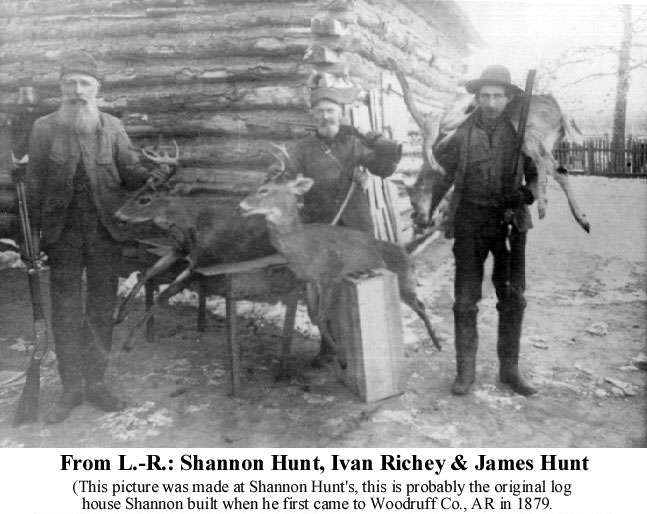
James Hunt's daughter, Mae, gave me this picture. She told me it was made at Shannon Hunt's house in Arkansas. I believe this log house to be the original log house that Shannon built when he first came to Woodruff County in 1879. Mae also told me, " My father, James, was Grandpa Alexander's oldest son. My father went to Arkansas four years straight to hunt with Shannon. He always left at Christmas and came back home on March 4th. Shannon started losing weight and was not well so he stopped going down because he did not want to be a bother."
May, " My father said, pretty risky going to Arkansas, it took me three days to go to Arkansas by train and it took Shannon six weeks when he went by flat boat."
The Military Road was about the only sign of civilization when the Hunt family arrived at this place. There was nothing but dense forest on either side of the road for miles and miles. Hardly a space could be found which would let the light of the sun pass through to the undisturbed soil. Heavy underbrush formed itself into one continuous mat in this marsh and swamp land. This wilderness swamp land and the dense forest was packed with bears, panthers, wild cats, wolves, deer, squirrels, rabbits, raccoons and other wild animals. The land was well timbered with oak, elm, ash, hickory, wild cherry, maple, black and white walnut, sycamore etc.
Indians had traveled this road for years, I'm sure they lived there as well, but by the time the Hunt family came to the area most of the Indians had been moved further west. However, they were still frequent travelers along the " Old Military Road" up into the early 1900's.There is a place on Sherman Hunt's old home place where many arrowheads have been found.
I have heard my aunt, Annie (Hunt) Wheeler tell this story; " I remember one time Grandma Hunt called mama on the telephone to tell her that some Indians had stopped by her house and they were headed down the road toward out house. Mama got the children in the house and we all hid. We were in no danger, all they wanted was food and they were curious about what we had in the house and would try to look in the windows. Never-the-less we were afraid. All mama had cooked was a plate of cold biscuits, which she sit on a fence post in front of the house. The Indians took the biscuits and put one on each post and rode on. I guess grandma gave them plenty of food and they were not hungry."
Although the Indians had been there for many years, there had never been an over-kill of the game, there was more than plenty for the new settlers. The Hunt family had wild game, fish from the creek, wild greens, nuts and fruit, and as soon as a place could be cleared they had a vegetable garden. Shannon did the farming with a home-made, wooden plow.
Shannon hunted the animals, not only for food but also for their pelts, which he sold for cash or traded for necessities that the land did not supply. It seems this family had a well-nourished and content life, their only concern was a better cash flow.
William Sherman, Shannon's older son, was only twelve years old when they came to this place. Since Shannon was not well after the war, I'm sure Sherman was doing the work of a grown man. He was most likely helping with the clearing and grubbing of the land and carrying a rifle beside his father. Hattie and Coot most likely had shores also, perhaps jobs in the vegetable garden and tending flocks of chickens. There were few children in the area and no schools. These children were far removed from the comforts and conveniences that children have today.
There were many inconveniencies for new settlers, for the Hunt family there was the inconveniencies of having to go to Wheatley for their mail, much of the time swimming their horses to get there. They also had to go to Wheatley to have their corn ground into meal, and to buy any staples such as coffee, sugar, flour, salt and various items that Elizabeth needed for medical supplies.
Elizabeth Ann Hunt was the only doctor, so to speak, in the area for several years. She was a " home country" doctor, no training, just the home remedies and herbal medications. She was also a mid-wife, delivering most of the babies that came into the world in the area, including many of her grandchildren. She kept her " little black bag " well supplied and ready, visiting her patients riding side-saddle, as the roads were often impassable for a carriage.
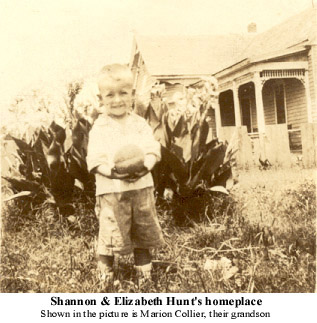
I was not aware until 1996, that Elizabeth's side-saddle had been kept in storage at the home of her daughter, Mary Hattie (Hunt) Wilson, in Cotton Plant, Arkansas. By the time I learned about it, it was gone. Mary, Hattie's grand-daughter, told me it was so rotten it practically fell apart when it was moved.
Hazel said, " Grandma and grandpa talked about Elizabeth being a mid-wife and taking care of the sick when they were in Indiana."
Shannon and Elizabeth would later built a nice frame house a short distance from a creek, it sat beside and faced " The Old Military Road." Shannon's dream had become reality.Shannon and Elizabeth were both deceased several years before I was born but their old home place stood for several years. I very vaguely remember this house.
At some point and time, the creek near their house became known as " Flat Fork Creek." There was a Flat Fork Creek in Warren County, Ohio, near where the Williams' family lived. I have wondered if it were Shannon and Elizabeth who gave this creek its name and if they had named it " Flat Fork Creek" from the creek in Warren County.
In 1954/55, drag lines were brought in and Flat Fork Creek was replaced by a large drainage ditch.
A steady cash flow continued to be a problem until Elizabeth noticed that wagons, carriages and stagecoaches were becoming more frequent on the Military Road. She being the keen, determined and energetic lady that she was, decided to open an inn. This inn was called, " Hunt's Inn" sometimes " Hunt's Wayside Station" the area soon became known as " Hunt's Station," and was later named Hunter for Shannon Hunt.
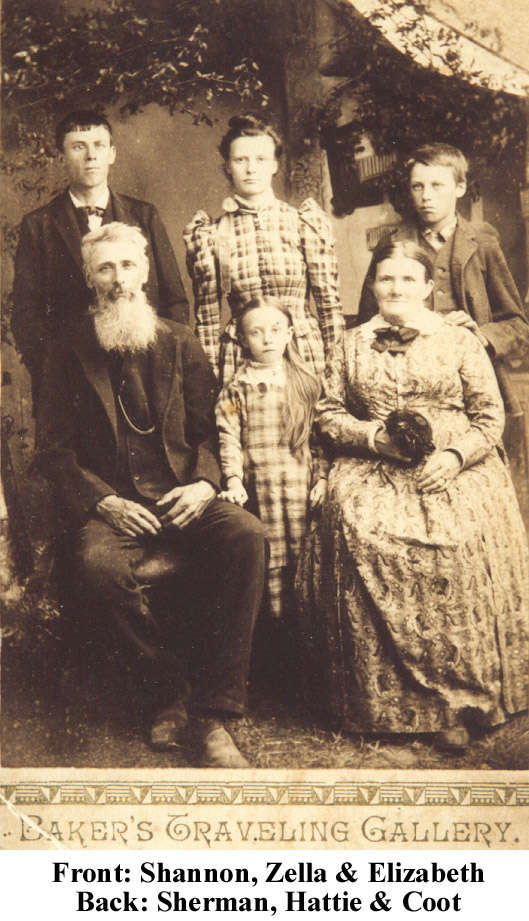
In 1881, a family by the name of Moreland moved into the area with one-hundred and twenty head of milk cows. As if Elizabeth did not have enough to do, she took on the job of milking twenty head of these fresh cows twice each day for half of the milk.(I can't even imagine anyone doing this.) She shipped the cream and had plenty of sweet milk, buttermilk and butter to serve her family and her customers.
In the mist of all of this, on Thursday, March 15, 1883, Shannon and Elizabeth was blessed with a new baby daughter. They named her Ella Zazella Hunt. Zella, as she would be called, was the only one of their four children to be born in Arkansas and the only one of the four children who would not be buried in the Hunter Cemetery, at Hunter, Woodruff County, Arkansas.
From Elizabeth's pictures she was a large, dominate looking woman. From what others have told me, she seemed to have been very opinionated, telling people what was on her mind, and determined to bend those who opposed her. She hurled herself at life, with chin forward, eyes blazing and must have had an unbelievable supply of energy.
As more people moved into the area, the concern for churches and schools began to grow. The Methodist Episcopal Church was the first church in the area, the first church building was erected in the mid 1880's. It was located about one-half mile from Hunt's Inn, on what would later become the O. A. Woodward farm. The first names on the church register were; Thomas N. Wilson, in 1885, and his wife, Harriett Wilson, in 1887; Elizabeth Hunt, by letter in 1888, Wm. J. Vick was pastor; Mary J. Brinneman; W.A. Lee; and Mary E. High. This building was completely destroyed by a cyclone in March 1898.
The first one room schools were; the Moorman School, Rabbit Ridge School, Green Frog School and Prairie View School. Elizabeth Hunt donated an acre of land for the Prairie View School to be built, it was located on a small prairie near Hunt's Inn. It was near and facing, " The Old Military Road."
More and more people were coming into the area and settling along the " Old Military Road" near Hunt's Inn. It was most likely thought that a town would spring up in this area, but in 1883, the Southwestern Improvement Association came in and mapped out the site for a proposed rail-road. The association filed a plat for a town in the NW quarter of section 17, township 5 N, Range 1W, in Woodruff County, Arkansas. Hunt's Inn was located in section 22, two miles south-east of this site. By 1885, tracks were being laid in the area for the Texas and St. Louis Railway, later this became the Cotton Belt Rail-road and still later the St. Louis Southwestern Rail-road.
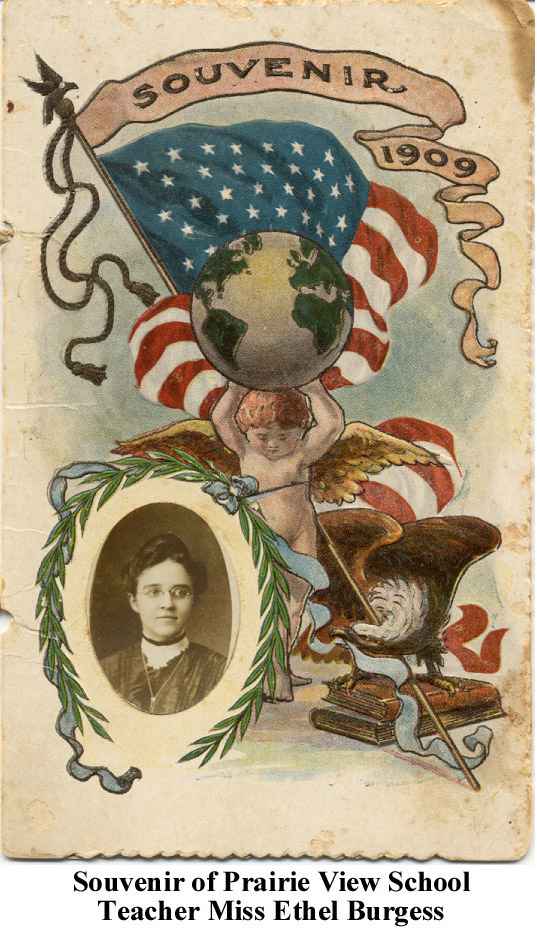
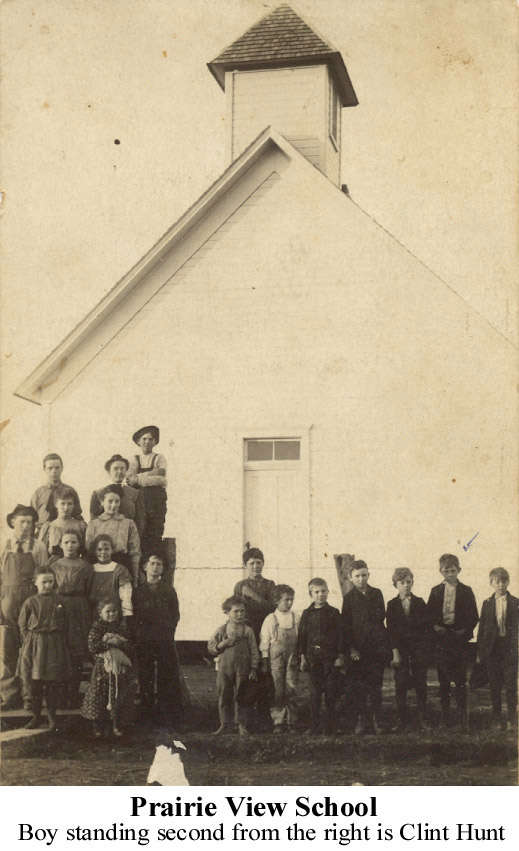
The rail-road brought much business to Hunt's Inn. It was the only place for miles around where the rail-road crew could go for home cooked meals. After the rail-road was in use, many men would ride the rails from the north to hunt in the area. Again this brought much business to Elizabeth Hunt's kitchen.
Interest in the area continued to grow, more and more families were arriving by covered wagon over mud-rutted roads, searching for homes and farms. Shannon Hunt's two sons, William Sherman and Sylvester Coot, decided there was need for better communications and established " The Hunt Brother's Telephone Company." This was the first telephone exchange in this part of Woodruff County. I have not been able to find the exact date this company began, but I have found where they extended the lines to Zent in 1906, then to Wheatley and Cotton Plant in 1910.
Sherman and Coot's brother-in-law, Seth Wilson, eventually abandoned farming and went in the telephone business with his brothers-in-laws. The name was changed to Hunt Bros. and Wilson Telephone Co. After the company extended lines to Cotton Plant, the company office was set up there with the Wilson's moving there to operate the office. This office was located above the old Will May's Five and Ten Cent Store.
It seems they started selling shares in the company and the company was not doing well. Sherman and Coot eventually turned the company over to their brother-in-law and went back into full time farming. At this time the company again had a name change to Wilson and Hunt Bros. Telephone System. The telephone company went out of business in the 1920's due to a bad ice storm.
By November 1885, paper work was being processed for a Post Office at Hunter. Charles A. Lawson was First Post Master General. The first Postmaster was W.R. Pettis.
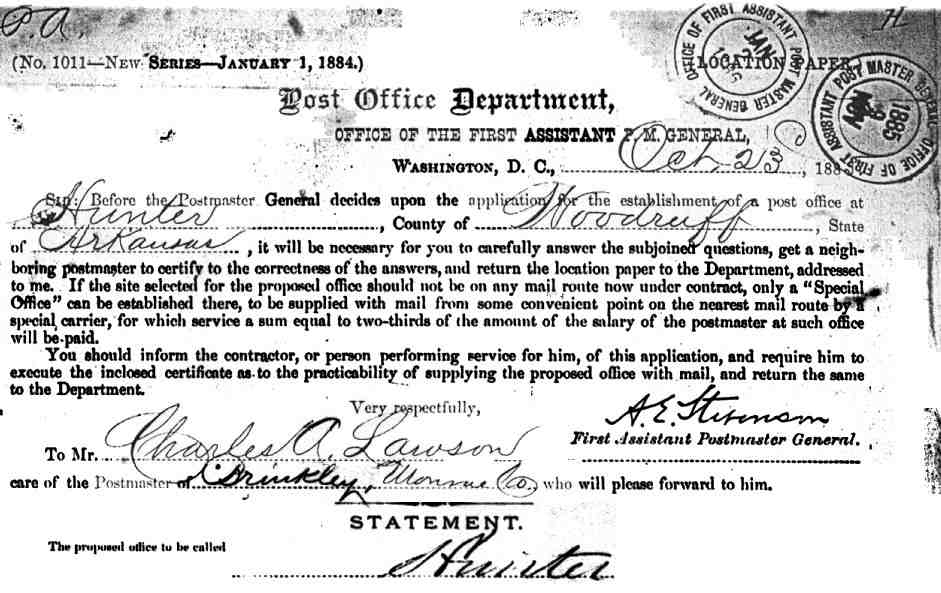
A partial copy of Nov. 1885 papers
Notice the proposed office is to be called Hunter
So.... How did Hunter get it's name?
We can see from Post Office records that while the town has gone by the name Hunter, at least, since 1885, it seems that it was not incorporated until much later. I have not seen documentation on this, but in " The History of Hunter," in 1976, Mrs. Balys Kennedy writes; " Early in the century, thirty-three land owners authorized J.R. Baker, B.S. Carlton, and W.L. Freeman to act in their behalf in presenting a petition to the County Court to incorporate the town of Hunter. The Court, remarking that the name of Hunter is right and suitable and that all other matters had been properly observed, ordered onJuly 3, 1906 that the said town of Hunter be incorporated as described in the petition. E.M. Carlee was the attorney handling incorporation details; Will Moorman was the Judge."
Mrs. Kennedy had explained in some of her writings why it is thought that Hunter was named for Shannon Hunt, but there seems to have been a few who doubt the fact that this was how Hunter came about it's name.
We know that Shannon and Elizabeth Hunt had the first business establishment in the area, which was known as " Hunt's Inn" and " Hunt's Wayside Station." Later the area became known as " Hunt's Station," and still later " Hunter." Hunter is now only a wide spot in the road and maybe it is not important how it got its name, but Hunter was named for Shannon Hunt!!
In 1994, Hazel (Hunt) Lewton told me, " Grandpa Alex told me that Hunter was named for Shannon Hunt. Shannon first chose the name Hunt but there was already a Hunt, Arkansas, his second choice was Huntsville, there was already a Huntsville, Arkansas. Shannon's third choice was Hunter and that was how Hunter got its name."
I have checked and found that Hunt, Arkansas was incorporated in 1881 and Huntsville, Arkansas was incorporated in 1884. When Hunter first got its post office in 1886, it states, " The proposed office is to be called Hunter." Hunter was not incorporated until July 02, 1906. I believe this evidence completely backs Hazel's story. It seems that Hunter could have been Hunt or Huntsville had there not have already been towns in Arkansas by these names.
The following article appeared in the Brinkley Argus, Brinkley, Arkansas, issued date, November 29, 1907, Hunter news section. This article was written just over one year after Hunter was incorporated. Why would this have been printed if it were not true?
(The Brinkley Argus - Dated, November 29, 1907, copied verbatim)
Hunter News
The town was named for Squire Edward Shannon Hunt, an old resident, as noted above, who came to this part of Woodruff County, from Indiana, in the year 1879. This was three years before the first train was run on the present Cotton Belt Rail-road.
Mr. Hunt lives about 2 miles south east of Hunter on the farm which he traded for in 1879. He was a federal soldier, served under Gen. Sherman, and was present at and took part in the final " Grand Review" of the armies of Grant and Sherman at Washington in 1865. He is one of the substantial citizens and successful farmers of this country.
I have been told all of my life, by family members and others, that Hunter was named for Edward Shannon Hunt. I believe the above evidence is more than enough to prove this to be a fact.
From - Gazetteer and Business Directory of Woodruff County, Arkansas 1888; Hunter, Woodruff County, a station on the Texas & St. Louis Railway. 30 miles southwest of Augusta, the County seat. Forrest City is the nearest banking point. Mail daily. Population 25.
The Bank of Hunter, Arkansas, was organized July 28, 1906, and was incorporated September 11, 1913. It seems the bank started having problems in 1920. On January 17, 1928, the board decided to voluntarily liquidate the bank by paying all depositors one hundred per cent of their deposits. After this was done, liquidation was closed on the same date.
North of the bank building there was a two story hotel and several other businesses. This part of town was called " Moccasin Gap" it burned in November of 1937.
The following is from " The Brinkley Argus" Date issued; 4-26-1912
On April 19, 1912, the Board of Directors of the District held a meeting at the office of the Hunter State Bank, in the town of Hunter. It was decided that " The Town of Hunter, Woodruff County, Arkansas" would erect a $15,000.00, concrete High School Building.
In July 1917, property, consisting of about 140 choice lots, was advertised to be sold, on the Main Street of Hunter. Every lot was sold by four o'clock that afternoon. The lots averaged about fifty dollars each. (From The Brinkley Argus, dated 6-8-1917)
Elizabeth Ann (Williams) Hunt passed away on Sunday, December 06, 1914
The following was copied verbatim from the Brinkley Argus, dated; Dec. 11, 1914
IN MEMORIAM
Mrs. E.S. HuntSunday, Dec. 6th, 1914, the death angel paused in his mysterious flight, hovered above the home of Shannon Hunt and took from it the wife and mother whose absence will cause the tears to flow and the heart to throb with grief for many years yet unborn.
Mrs. Hunt had reached the ripe age of seventy-five years. She was born in Warren County, Ohio, in the year of eighteen hundred forty-one. The years of her youth skimmed by peacefully until the clouds of the Civil War appeared upon the horizon and swept into its awfully madstorm her youthful sweetheart who answered the call of the Stars and Stripes, with the patriotic determination of serving his country, though service meant death. After the end of war when peace once more smiled upon out land and flowers grew where men had fallen in battle, the young people realized their dreams and were married in the year eighteen hundred sixty-five. Even afterwards through trials and tribulations, through joy and happiness, whether fortune frowned or whether she smiled, they coasted the path of life together until the death angle broke the hand-clasp and ushered the wife and mother into those realms above where cheeks are never stained by tears of grief.
During the year eighteen hundred and seventy-nine they moved to their present home, which is situated on the Military Road, near the little town of Hunter. They were one of six families of this whole country, pioneers who blazed the way for other to follow in after years. The forests had never echoed to the sounds of a locomotive's blast. No barbed wire hindered the wild deer's flight across the unbroken expanse of prairie. Excepting the Military Road there was no sign of the touch of civilization's hand. In the midst of this wildness four children were born to brighten the home and to cheer their parents when their temples were streaked with locks of gray.
Grandma Hunt as she was familiarly called by her friends was an angel of mercy in time of sickness. She was an excellent nurse and her knowledge of the old simple but effective remedies should put a physician's skills to shame in many cases. During the growth of the settlement there was not a home that had not felt the touch of her administering hand and the influence of her healing remedies which restored health when disease had larked.
A call for help she never turned a deaf ear to. No matter if the trees were bent with loads of snow and sleet; or if freezing wind penetrated her clothing and chilled her through; or if the creeks swam her horse and the slashes were sees of water she responded to every call for aid with never a thought of her own welfare of comfort. But that helping hand is stilled forever, her cheerful voice shall soothe the sick no more with words of kindness. In the words of Tennyson we shall grieve.
" Oh, for the touch of a vanished hand
And the sound of a voice that is still."If a soul has ever taken flight heavenward, her's has winged its way through eternal realms into the Heaven of Rest where the voices of angels shall blend into musical songs and made the gates of heaven quiver with melodies never heard on land or sea. Her life of service in this world shall claim its reward of rest in the next.
The old home will never be the same. Many a sigh will echo faintly through its halls. There will be a missing link in the chain of happiness. A glance at the vacant chair will be the signal for the tear yet unshed to flow. What is fir shall be ashes. Where there is life there shall be death. The body shall return to dust but the soul endureth forever.
Signed; Hunter Correspondent, name not given.
For some reason Shannon and Elizabeth were not enumerated in the 1910 census, Woodruff County, Caney Township, but they were still living there. In the 1920 census, at Shannon Hunt's home, Will Collier was listed as head of the house-hold. Others in the house-hold were: Zella, Marion, Aileen and E. S.(Shannon) Hunt. Shannon's younger daughter, Zella, had married Will Collier. Zella and her family had moved into the house with Shannon so she could care of him. Shannon and Elizabeth Hunt's old home place was sold soon after the 1920 census were taken. It was first sold to Byron Vance, second to John Cooper, and later to the Tip Nicholson family. To my knowledge it is still owned by the Nicholson family.
After the home place was sold, Zella, her family and Shannon, moved to Cotton Plant where Shannon died on Monday, April 03, 1923. The following is Shannon's Obituary as printed in the Arkansas Democrat, on April 04, 1923.
Edward S. Hunt
Cotton Plant, April 4 __ Edward Shannon Hunt, aged 82, died at the home of his daughter, Mrs. W.H. Collier, at 10 p.m. Monday. Mr. Hunt enlisted in the Federal army in 1861 and served the entire four years of the war. He came to Woodruff County from Indiana and settled at what is now Hunter in 1878, coming to Cotton Plant in 1920. The funeral was conducted by Rev. Decker in the Methodist Church at Hunter Tuesday at 2 p.m. Interment was in Hunter Cemetery, by the side of his wife, who died in 1914. Surviving children are W.S. and S.C. Hunt of Hunter, Mrs. S.B. Wilson and Mrs. W.H. Collier of Cotton Plant.
(NOTE: I have Shannon's military records, he did not enlist in the Civil War until February 17th, 1864, he only served about a year and a half and they didn't come to Woodruff County, Arkansas until 1879)
Shannon played the fiddle, I'm sure he would have played for the many Square Dances, which I have heard so much about, that was held in Sherman Hunt's barn. When Shannon was on his death bed he ask to be sit up, then ask for his fiddle. He was playing " Turkey in the Straw" when he fell dead.
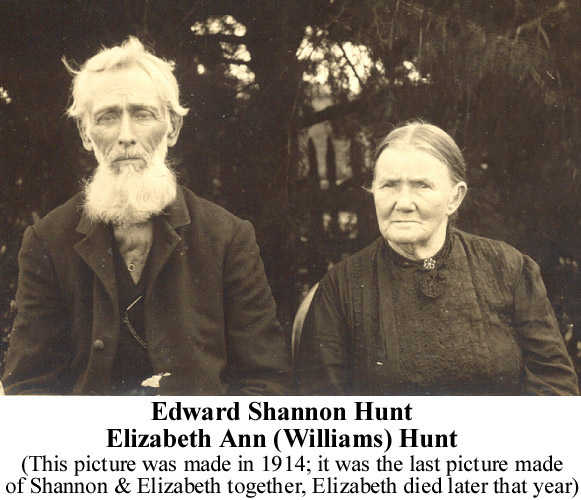
History states that at the time of Shannon's death, he was the oldest Pioneer of Caney Township.
It took Fight, Toil and Courage, but they had carved out a living from this wilderness frontier, and had traveled the journey of life together for 48 years. They left their children the respectability they could cherish.
Shannon and Elizabeth did not become rich or famous. All that is left are a few old stories, a few old photos and their graves marked with old stones placed at the time of their deaths.
It has been my purpose to correct and to set down a few events of their lives so what stories we know will be correct and will not be forgotten..........So that future generations will know who Edward Shannon Hunt and Elizabeth Ann (Williams) Hunt were and be proud that they can call them their ancestors.
" A FAMILY TREE CAN WITHER IF NO ONE TENDS ITS ROOTS"
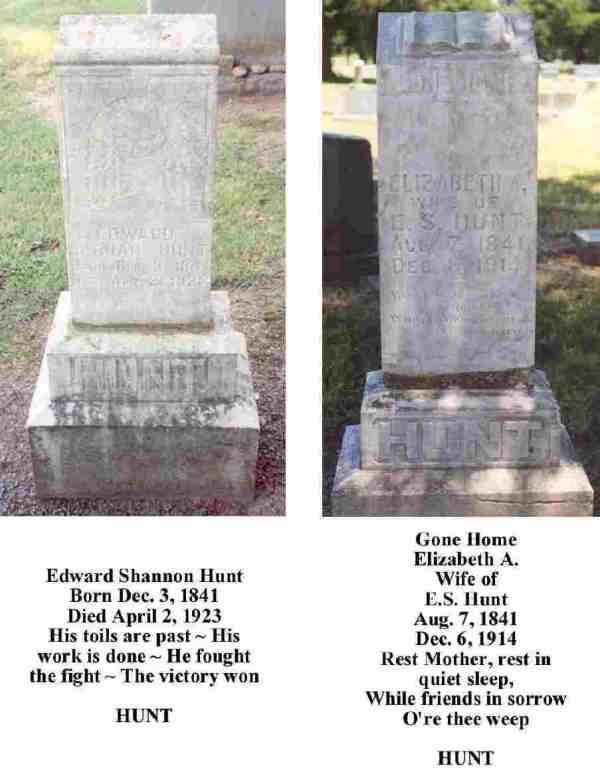
(Note: Shannon's birth date was December 03, 1842 & Elizabeth's birth date was August 07, 1844)
Children of Edward Shannon Hunt & Elizabeth Ann (Williams) Hunt
William Sherman Hunt was born on Sunday, June 09, 1867. He was born north of Markle, in Union Township, Huntington County, Indiana. The area was known as " The Prairie Lands." I suspect he got his name from Gen. William T. Sherman, the General his father served under when he was in the Civil War. On October 24, 1897, in Hunter, Woodruff County, Arkansas, he married Ira Arvilla Caskey. She was born October 27, 1879, in Palestine, Shelby County, Ohio.
Sherman always said he wanted to live and die on the " Old Military Road." He died on September 01, 1955, only a short distance from his old home place and near " The Old Military Road." Arvilla died February 16, 1960, at the Mercy Hospital in Brinkley, Monroe County, Arkansas. They are buried in the Hunter Cemetery, Hunter, Woodruff County, Arkansas.
Sherman and Arvilla had seven children, all born in Hunter and are all buried in the Hunter Cemetery. Several of their grand-children rest there as well.
Children of Sherman and Arvilla Hunt
Marvin Clinton Hunt; born September 10, 1898, died June 22, 1988. Clint married Maud Coleman on September 28, 1921. They had three children; Doris Evelyn Hunt; Earl Benjiman Hunt and Wayne Franklin Hunt.
Anna Alice " Annie" Hunt; born April 03, 1901, died June 12, 1984. Annie married Elmer Wheeler on January 03, 1924. Elmer died six years after they were married, there were no children. Annie never remarried. She helped to raise several of her nieces and nephews, she was like my second mother. Annie was well respected by all who knew her. She worked for many years in the Hunter School Cafeteria. She became known as Aunt Annie to many in the Hunter area.
Clarence Burnis Hunt; born August 20, 1902, died February 12, 1923. Clarence was never married.
Edith Elva Hunt; born November 11, 1904, died April 24, 1986. Edith married Jesse Cleveland Cary on March 28, 1928. They had three children; Jesse Ray " Sonny" Cary; James Clay " Buck" Cary and Mary Alice Cary.
Oris Eugene Hunt; born December 12, 1907, died February 07, 1935. Eugene was never married.
Dorothy Mildred Hunt; born December 17, 1913, died September 07, 1955. Mildred married Leroy Eugene Ousley on December 05, 1931. They had two children; William Odell Ousley, still born on March 04, 1933; andDorothy Imogene Ousley, born August 30th 1937. Imogene married Donald Eugene Vanderburg on June 27, 1955. They have two children Devonna Faye (Vanderburg) Culpepper and Darrell Kent Vanderburg. Darrell has Muscular Dystrophy, he is confined to a wheel chair and lives with his parents.
Ray Carnell Hunt; born August 31, 1916, died April 08, 1994. Ray married Maggie Clayton on December 28, 1945. Maggie had a son,James " Butch" when they married and they had three children; Joyce Carolyn Hunt; David Ray Hunt and Janice Louise Hunt.
Mary Hattie Hunt was born on Sunday, August 13, 1871. She was born north of Markle, Union Township, Huntington County, Indiana. On November 22, 1871, she married Seth B. Wilson, born April 13, 1864, in Newark, Lincoln County, Ohio. Hattie died April 14, 1959 in Cotton Plant, Woodruff County, Arkansas. Seth died February 24, 1949 in Cotton Plant. They are both buried in the Hunter Cemetery, Hunter, Arkansas.
Children of Seth and Hattie (Hunt) Wilson
Effie Wilson; born November 09, 1889, died April 1974. She married Boyd Angus on December 24, 1908. They had one son Wilson Boyd Angus.
Elsie Wilson; born February 27, 1993, died October 20, 1898.
Naomi Wilson; born July 18, 1898, died August 06, 1899.
Mary Esther Wilson; born March 22, 1906, died June 13 1996. She married George Sims, they had one daughter, Mary Sims.
Sylvester Coot Hunt was born on Monday, November 06, 1876. He was born north of Markle, Union Township, Huntington County, Indiana. On December 24,1897, he married Sally Mae Alexander, born October 05, 1877, in Grenada, Mississippi. Coot died June 04, 1956 in Brinkley, Monroe County, Arkansas. Sally died August 24, 1961, in Memphis, Shelby County, Tennessee. They are buried in the Hunter Cemetery, Hunter, Arkansas.
Children of Coot and Sally Hunt
Lester Clyde Hunt; born June 21, 1899, died March 08, 1986. He married Lollie Mae Thomas. Their children were; Mabel, Faye, Wendell, Joyce Ann, Billy Joe and Glenda.
Clem Chester Hunt; born February 16, 1901, died February 16, 1980. He married Frances Mae Hamilton on November 24, 1926. They had one daughter,Dorothy.
Eldon Ray Hunt; born November 23, 1903, died June 03, 1993. He married Mary Angie Gousset on June 26, 1927. They had no children.
Olin Udell Hunt; born February 01,1910, died February 23,1980. He married Stella Mae Vance on July 02, 1928. They had no children.
Wendell Leon Hunt; born November 30, 1919, died October 22, 1975. He married Gretchen Snyder, they had two sons, Tommy Lee and Richard Leon.
Ella Zazella Hunt was born on Thursday, March 15, 1883, in Hunter, Woodruff County, Arkansas. On May 24, 1909, she married William Harrison Collier, born August 23, 1885. Zella died January 30, 1962, in Owensboro, Daviess County, Kentucky. Will died March 08, 1948, in Owensboro, Kentucky. They are both buried in the Elmwood Cemetery, Owensboro, Daviess County, Kentucky. This cemetery is located at: 1300 Old Hartford Road, Owensboro, KY.
Children of Will and Zella (Hunt) Collier
Aileen Collier was born May 12, 1910, in Hunter, Woodruff County, Arkansas. On October 10, 1931, she married Marion A. Henderson. There were no children to this union. She died on December 30, 1978. She is buried in the Elmwood Cemetery in Owensboro, Kentucky.
Marion Collie was born September 22, 1915, in Hunter, Woodruff County, Arkansas. On July 22, 1946, he married Lenora Warner. There were no children to this union. Lenora died and Marion married Norma Berryman. There were no children to this union. Marion died June 29, 1998. He is buried in Memorial Garden, just outside Owensboro, Davies County, Kentucky.
Farrell Collier was born June 27, 1921, in Cotton Plant, Woodruff County, Arkansas. On February 14, 1945, Farrell married Virginia Nell Taylor. Ferrell was killed in a car crash on February 12, 1969. Ferrell and Virginia has five children; Karen Dale Collier, born October 16, 1945 and died November 01, 1945. She is buried in Elmwood Cemetery, Owensboro, Kentucky; Ronald William Collier; Stephen Dale Collier; Phillip Taylor Collier; and Kathryn Dale Collier.
Elizabeth Ann (Williams) Hunt was the oldest of fourteen children born to Simeon B. Williams and Cynthia Ellen (Ward) Williams. There were two sets of twins and a set of triplets in this family.
Simeon Williams was also a Civil War soldier, serving in Co. A, 35th. Reg. OVI. He was a drummer.

